
CONTENT WARNINGS FOR RAPE, SEXUAL ASSAULT, AND CHILD SEXUAL ASSAULT.
[Editor’s Note: This is the first in a two-part series examining agency in regards to characters in Westworld. This piece contains major spoilers for Westworld (2016—), Neon Genesis Evangelion (1996) and The End of Evangelion (1997).]
The thing that drew me in about Westworld was not the Wild West setting or the period costumes. (The costumes, for me, are a nice bonus.) The thing that drew me in about Westworld was one of my favorite tropes: beings who look human but may not be fully realized in this way, grappling with sapience, sentience, and the concept of humanity.
This is pretty much my favorite sci-fi trope of all time. I see it constantly in anime – characters like Yuki Nagato from The Melancholy of Haruhi Suzumiya and Irisviel from Fate/Zero, in particular, stand out – but it’s not covered the same way in Western media. Often, these sorts of characters ultimately forego this deeper psychological struggle in favor of highlighting action scenes.
The farther into Westworld I got, the more I found myself comparing Dolores Abernathy’s journey to sentience and grappling with her burgeoning humanity to that of Rei Ayanami from my favorite anime, Neon Genesis Evangelion.
Dolores’ and Rei’s narratives parallel each other in that their journeys are about claiming agency for themselves from people who hold power over them – most often men, and particularly those with some sort of sexual interest. Both characters are seen as a means to an end in their narratives rather than fully formed creations with their own wants, desires, fears, and thoughts.

We first meet Dolores staring straight into the camera as seen above, responding to stimuli and questions asked to her by a prominent employee of the company that owns Westworld, Delos. It’s here she’s at her most stereotypically “robotic” moving in an almost unnerving fashion and only speaking in short, clipped sentences.
We find out that Dolores is the oldest android in the park. She appears naked and looks battered and beaten, a common thread for ‘hosts’ (the show’s word for the androids who populate the Westworld theme park) in this sort of setting. Nudity among hosts is common in the show – it’s meant to dehumanize them to the employees (and to a degree, the audience.) Staff members are trained to see them as nothing more than living dolls meant to entertain wealthy park guests – who can select do anything they want to the hosts, including murder and/or rape.
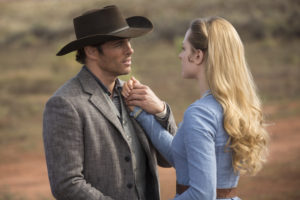
Dolores’ storyline in Westworld centers around these crimes – to the point where James Marsden’s character, Teddy, is a host designed to “lose” to a guest whose “victory” entails getting the girl. Whether the guest charms Dolores into sleeping with them or kills Teddy and rapes her (with the possible addition of killing her, too), Teddy never “wins.”
Not only does this sort of storyline imply toxic schools of thought in regards to power dynamics and relationships. It also takes any agency Dolores may have had in the situation away from her. At the end of the day (whether it ends as normal or she is killed), Dolores’ day resets again, leaving her with no memory of the horrors inflicted upon her at the hands of park guests and by her designers the day before. Still, Dolores portrayed in the park as a kind, compassionate, and caring farmer’s daughter, a skilled horseback rider and a landscape artist. She believes in order and feels optimism toward her situation and those of others.
This starts to change upon Dolores’ awakening to sentience and understanding. Upgrades to various hosts’ systems allow for ‘reveries’, or moments where hosts can reclaim significant memories of their previous experiences in dreams. As it’s too expensive for the park to wipe a host’s memory each day completely. These are stored in their minds, dormant in a backlog.
Dolores experiences reveries and is awakened fully to the stirrings of sentience with a recurring code word whispered in her ear by her father. Who has gone mad upon achieving knowledge of the outside world and his place in it: “These violent delights have violent ends,” from Act 2, Scene 6 of William Shakespeare’s Romeo and Juliet.
This phrase is significant foreshadowing. Later in the series, we discover that each host has the ability to unlock sentience programmed into their minds. The host can only accomplish this task by experiencing the gamut of human experiences and emotions — especially suffering. The introspective nature of this feeling can lead beings to question the nature of their reality and their humanity.
We consistently see Dolores taking more and more steps to fight back against those who may hold power over her or to try and understand her intelligence and sapience in new ways. Arnold, her creator, is shown reading to her specific passages from Alice’s Adventures in Wonderland in hopes of awakening her possible sentience early. We flash between scenes of Dolores with a recurring guest, William, who takes a bona fide and genuine interest in her. Scenes of Dolores and Teddy, who usually doesn’t live long. Scenes of Dolores speaking to various techs in the Delos organization; and even some scenes featuring the Man in Black, a truly villainous character who is very fixated on Dolores, committing some of the most heinous and graphic sexual and violent acts against her in the show.
We later find out that Dolores’ storyline shifts into 30-year chunks, and that William and the Man in Black are the same man, 30 years apart. William returns to the park and finds Dolores does not remember him or their adventures at all, which causes him to follow a more evil path.
Dolores’ transformation is key to her retaking her agency back from her oppressors. It’s evident in the final scene of the first episode, where she’s seen smashing a fly that lands on her. Dolores begins to break free of her coding in this way, as hosts are programmed to never be able to harm something living. (Literally, “they couldn’t hurt a fly.”)
This concept is taken to the next level about halfway through the young William storyline, where Dolores – who was previously shown as unable to fire a gun – actually shoots an opponent. When asked why, she says, “I imagined a story where I didn’t have to be the damsel.”

That was the moment where the Rei-Dolores parallel really clicked for me. The comparison only gained strength from there.
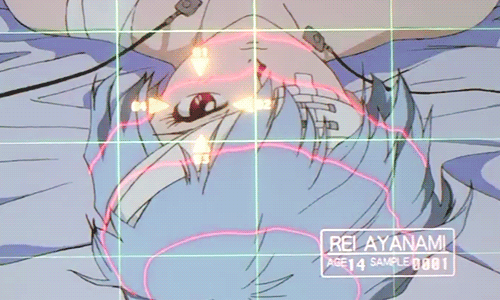
When we first meet Rei in person on Neon Genesis Evangelion, we find her bloodied and bruised on a hospital gurney, being pulled away after an experiment with what appears to be a giant robot called an Evangelion unit. Rei is quiet, aloof, and mostly unsociable in the beginning. At first, it’s only through main character Shinji’s father Gendo Ikari that we see Rei chatting and smiling amiably. Gendo’s relationship with Rei is a complicated and problematic one, as we later find out that Rei is a clone of Gendo’s dead wife Yui combined with the genetic material of a primordial being called Lilith.
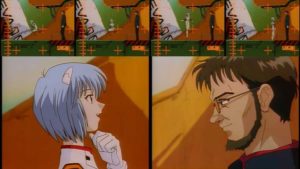 Rei is seen as both a daughter figure for Gendo and also a figure onto which he can project thoughts of his dead wife. Because Rei has been brought up blind to the outside world with Gendo raising her, most of her time spent in a secret base below her city, she isn’t aware of just how toxic this relationship is. She instead idolizes Gendo: at that point in her story, he’s the only person who has shown her any kindness.
Rei is seen as both a daughter figure for Gendo and also a figure onto which he can project thoughts of his dead wife. Because Rei has been brought up blind to the outside world with Gendo raising her, most of her time spent in a secret base below her city, she isn’t aware of just how toxic this relationship is. She instead idolizes Gendo: at that point in her story, he’s the only person who has shown her any kindness.
We see Rei’s apartment, and it’s barren, bloody, and covered in medicines (which are implied to be keeping Rei’s form stable, similarly to how hosts on Westworld need maintenance to stay active). Shinji visits her to drop off homework, as she’s absent for a few days – she emerges naked, something that does not faze her. Due to her inhuman nature and the way she’s treated as such by others. She is not disturbed by this, nor is she when Shinji falls on her – she just asks him to move.
Rei is continually made powerless by the narrative through her relationship with Gendo as well as her contemplation of her own existence. She begins to gain her own agency and reclaims her humanity through his son, Shinji. She shows her true kindness rather than kindness to serve his own darker agendas. Whether it be thoughts of his dead wife or a secret plan to cause the Apocalypse and meld all of human consciousness into the primordial soup from whence it came.
Rei grows stronger through this positive connection, even contemplating her own existence multiple times – as examined in the Rei’s Poem sequence, one of the most famous in the series.
As theorized by the above link to the EvaGeeks wiki, Rei’s poem sequence directly deals with her subconscious confronting her own existence, her humanity, and her sentience. Various lines are referring to her questioning her own sense of self. Later in the series, she mentions that “If [she] dies, [she] can be replaced.” We’re led to believe this means she holds no value towards her own life and can be replaced with a new pilot, but it’s more sinister than that.
It turns out that like a Westworld host, Rei has lived multiple lives. The Rei we see throughout Neon Genesis Evangelion is actually the second incarnation of Rei. The first strangled to death as a young child.
Rei was grown in a lab, and there are multiple clones of her residing in an underground lab – this even goes so far as to have the equipment used to test Evangelion units be marked ‘Rei’, as her consciousness is used to simulate a pilot. When a Rei body dies, a new Rei can take her place – bringing along some memories from her previous life into the next incarnation. In this way, Rei’s life is truly not her own.
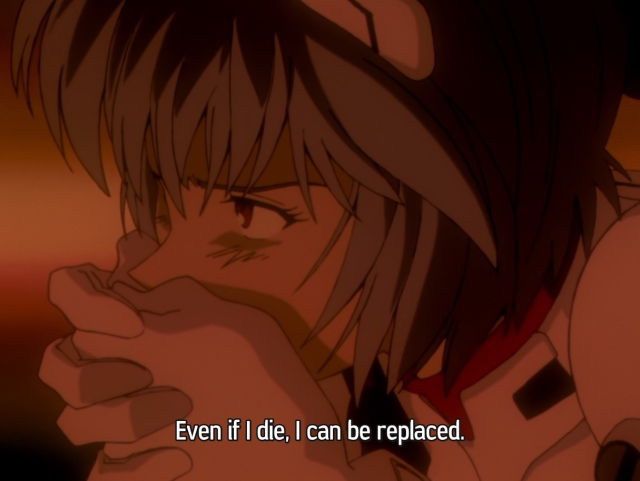
She regains some of this agency throughout the series. As she gets closer to Shinji and learns more about emotions and humanity. A few episodes after her poem, this incarnation takes back her agency in its ultimate way – by sacrificing herself in battle against the invading primordial Angel called Armisael to save her fellow pilot. The imagery in this scene is truly disturbing. As the Angel begins to corrupt her body and take over her Evangelion unit, sending vein-like formations up her body and causing her physical pain. Still, she works through it, making her sacrifice in the line of battle.
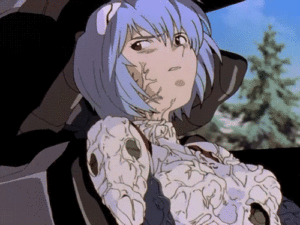
But sure enough, Rei III returns the next day, memories of her previous life still intact.
This Rei is more vengeful, seeing Gendo as a manipulator rather than a savior. Ultimately, this is where she and Dolores tie together. In the film The End of Evangelion, Gendo tries to merge the primordial being Adam with Rei’s body (which is grotesquely falling apart at that point). She’s naked again in this scene and being commanded, similarly to the hosts in the examination rooms of Westworld. Her humanity and comfort cast aside as she’s physically violated by Gendo.
Rei refuses to allow him control as she merges, transferring power over to herself and Shinji instead. Gendo orders her to reunite him with Yui – she replies, “I will not be a puppet for you to control.” He asks, “Why?” and she says “Because I am not like you.” In accepting her sentience by choosing to exist beside humanity, she gains control of her agency to fight back against her abuser. Rei merges with the body of primordial being Lilith, working to merge all human consciousness together – and then, with Shinji, works to help everyone realize their individuality.
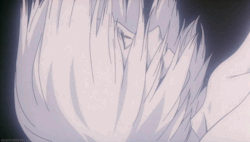
Late in the first season of Westworld, Dolores awakens a latent personality in herself – that of Wyatt, a former soldier who believes he’s spoken to by God. Multiple hosts – including Dolores herself – have been spoken to by voices before. Which turn out to be the uploaded consciousness of Arnold, one of their creators, urging them to gain sentience and consciousness themselves. Dolores gains full consciousness by merging with this figure Wyatt, who is vengeful and violent. She murders various humans in the park, echoing the actions of the Gunslinger from the original film and starting a veritable host revolution against their captors.

Westworld left us here and went on a long hiatus. Multiple manmade beings gained sentience and triumphed over abusers, gaining agency. I’ll write about this topic in detail in a future piece, but I’m interested to see where Dolores/Wyatt takes us in season two and what else Westworld has to say in regards to agency narratives.
I’m not sure if Rei’s ending provides her a clear recovery narrative from the trauma she’s faced in the show due to the ambiguous ending of End of Evangelion. After Rei and Shinji help humanity to realize their individuality, the giant being comprised of Rei and Lilith is literally broken. She begins decomposing grotesquely and falls to the blood-stained earth below, her giant face twisted into a smile. The only two beings who have awakened fully are Shinji and another pilot, Asuka, with the hope that everyone else can eventually regain their individual forms too. It’s… pretty bleak, but that’s keeping in tone with the rest of the series.
I definitely want Dolores to gain her own agency fully and self-actualize. I’m not sure I’d like it to be as bleak as Rei’s path. Despite everything, I really want Dolores to have a true happy ending. She deserves it.



![[REVIEW] WII U TO CURRENT GEN DEBUT WITH THE WONDERFUL 101: REMASTERED](https://geekd-out.com/wp-content/uploads/2020/06/Wonderful101Remastered-Main-150x150.jpg)